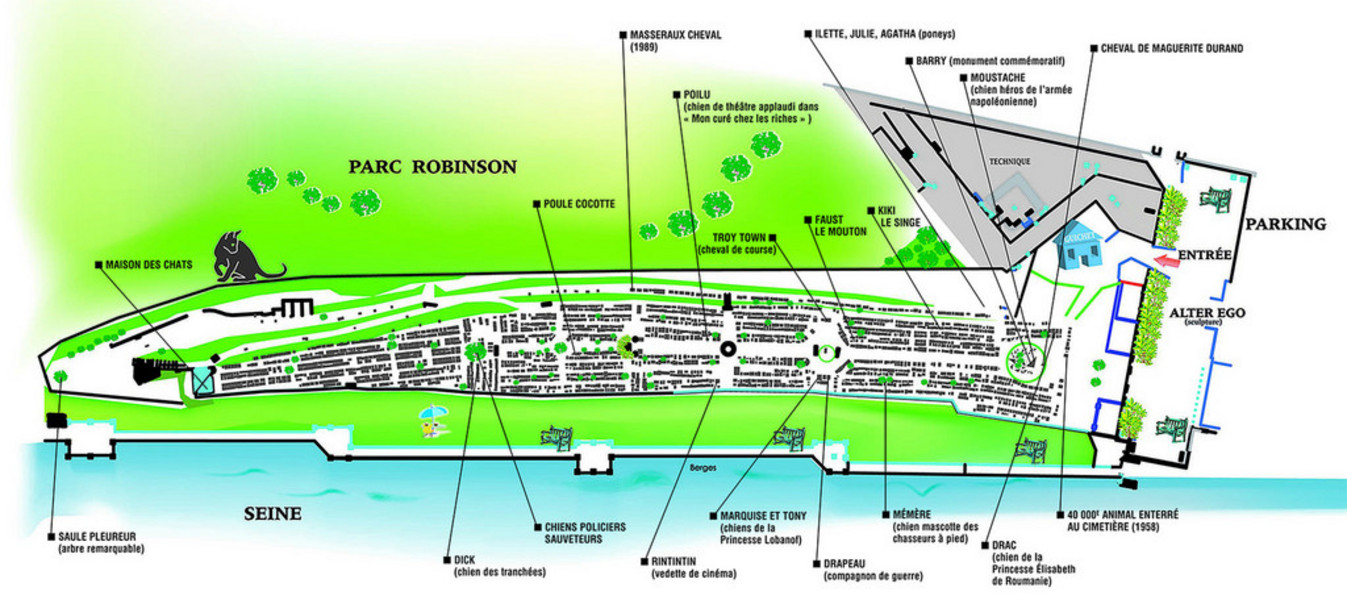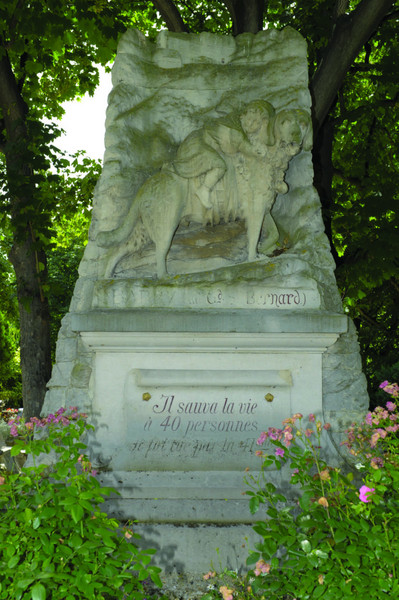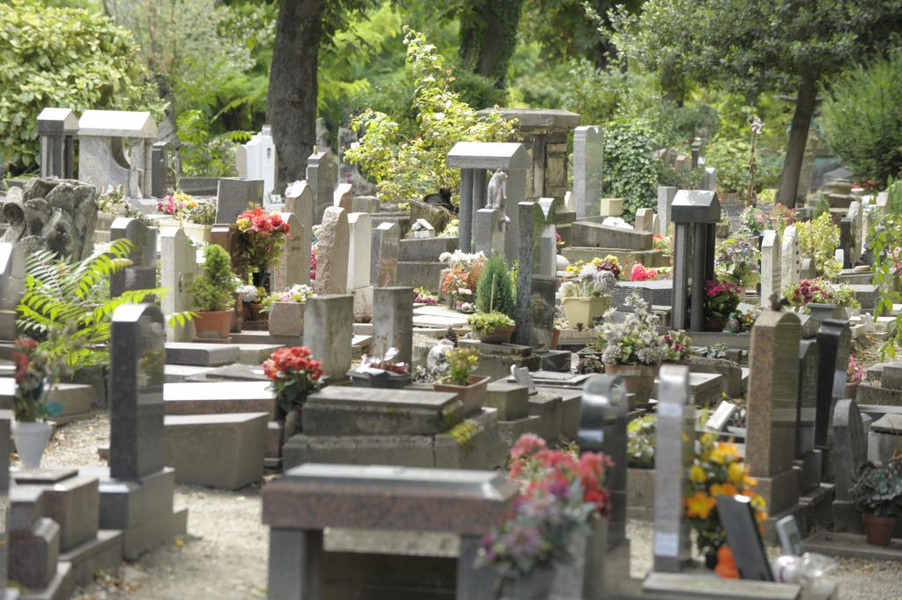

The dog cemetery

Animal living conditions improved considerably during the 19th century. Slowly, the function of the animal changes. From utility, it becomes pet and now contributes to the quality of life of men. In 1824, an Animal Protection Society was founded in England. In 1845, outraged by the mistreatment of horses, Count de Grammont founded the French SPA.
In 2019, the dog cemetery celebrated its 120th anniversary. On this occasion, the Town Hall organized the unveiling of the “Alter ego” sculpture created by the Asniéro artist KASPER, storytelling tours, exhibitions, workshops for children, jazz concerts and activities.
Cemetery plan
 Le_cimetiere_des_chiens_2.jpeg
Le_cimetiere_des_chiens_2.jpeg
You can view and enlarge the plan by clicking on the image.
A status for pets
If the living conditions of animals improve during their lifetime, nothing is planned after their death.
In theory, the corpses should be brought to the knacker within twenty-four hours. In practice, in Paris, the remains are most often thrown away with household waste, when they are not thrown into the Seine or into the ditches of the fortifications.
With the law of June 21, 1898 which specifies that domestic animals may be buried "in a pit located as far as possible one hundred meters from homes and in such a way that the corpse is covered with a layer of earth having at least one meter of depth." 'thickness', the opening of an animal cemetery becomes possible.
It is this task that a lawyer, Georges Harmois, and a feminist journalist, Marguerite Durand, will tackle. All that remained was to find, in Paris, a place located, as required by law, one hundred meters from any dwelling...
The creation of the Asnières dog cemetery
Located northwest of Paris, on the left bank of the Seine, the town of Asnières-sur-Seine was, in the 19th century, a favorite Sunday destination for Parisians in search of greenery and entertainment. The island of Ravageurs then faces the much appreciated banks of the Seine. At the time, it was occupied by ragpickers who collected fabrics, metals and other abandoned objects to resell them.
Taking advantage of the brand new law authorizing the burial of animals, Georges Harmois and Marguerite Durand created the Société Française Anonyme du Cimetière pour Chiens et autres Animaux Domestiques on May 2, 1899 and, on June 15, 1899, the company purchased the company from Baron de Bosmolet. half of the island of Ravageurs located upstream of the Clichy bridge.
After obtaining assurance that the law of June 21, 1898 on the burying of domestic animals would be respected, the Prefect did not oppose the creation of the cemetery.
This cemetery, the first of its kind, was officially opened to the public at the end of the summer of 1899. Several constructions were planned, such as a columbarium and a museum of domestic animals, but only the gardens, the entrance building and the necropolis were carried out. The latter is divided into four districts: that of dogs, that of cats, that of birds and that of other animals. The Parisian architect Eugène Petit, whose signature several buildings in the 14th arrondissement bear, was responsible for designing the entrance to the cemetery. He will design the Art Nouveau style gate, flanked by two doors for pedestrians to pass through. In 1976, the filling of the arm of the Seine, made possible by the disappearance of a second island, Robinson Island, caused the cemetery to lose its island character.
After its creation, the cemetery enjoyed increasing success but encountered chronic difficulties. The latest was in 1986 when the board of directors decided to stop all activity and definitively close the cemetery for the month of September 1987. Very moved, the concessionaires and lovers of the old cemetery mobilized. The Asnières Town Hall then prepared a rescue plan and requested in particular the classification of the site.
On June 29, 1987, the Departmental Commission of Hauts-de-Seine, at the request of the Minister of Equipment, Pierre Méhaignerie, registered the site of the dog cemetery given its “interest which is both picturesque, artistic, historical and legendary”.
In May 1989, the Asnières Town Hall purchased the land from the Société Française Anonyme du Cimetière pour Chiens et autres Animaux Domestiques and entrusted its management to an independent company. Later, in 1996, the Hauts-de-Seine General Council completed the work to consolidate the banks connecting the Robinson Park terrace to the Van Gogh port via a promenade along the Seine dotted with pergolas.
Finally, on February 1, 1997, the Town Hall of Asnières-sur-Seine took definitive control of the management of the cemetery.
Cemetery tenants

Over the years, the cemetery has been populated with monuments and important burials. From 1900, the management erected, facing the entrance to the cemetery, a monument to the glory of Barry. This dog, which lived at the beginning of the 19th century, belonged to the monks of the hospice of the great Saint Bernard. Legend has it that after “saving the lives of 40 people, he was killed by the 41st!…”
Another witness to the bond uniting men and animals is the monument erected in memory of police dogs who fell victim to duty. Built in 1912, a few years after suburban police stations were equipped with police dogs, it houses Dora (1907-1920), from the Asnières police station; Top, several times medalist; Papillon, eight years of service in the 16th arrondissement; Leo, killed in service...
Star animals and star animals have also found a final refuge at the Asnières cemetery. Rintintin, the valiant hero of the television series; Prince of Wales, whose epitaph explains that he “appeared 406 times on the stage of the Théâtre du Gymnase” in 1905 and 1906; Kroumir, Henri de Rochefort's cat, who is said to have died of grief four days after his master; the pets of Camille Saint-Saëns, Courteline, Sacha Guitry, princes and dukes…
But the Asnières cemetery would be nothing without the multitude of anonymous people, dogs, cats, birds, rabbits, turtles, mice, hamsters, fish, horses, and even monkeys, gazelles, fennecs, lemurs, whose tombs are richly sculpted or simply flowers show the affection of their masters. Thus, during a random walk, we can discover the gratitude of a mother to whom the dog Loulou “returned her child who in 1895 drowned in the Garonne. The brave Loulou was only nine months old and also had a broken leg...".
Further on, a small stone dog extends its paw to a helmeted soldier. It’s Mémère, born in 1914, and who remained the mascot of the hunters on foot for fifteen years. Elsewhere, on marble plaques, surrounded by flowers, a name, two dates and a photo. For Pupuce, Sultan, Minouchette, Ulysse or Rubis.
Finally, anonymous among anonymous people, a stray dog came to die on May 15, 1958, at the gates of the cemetery. The management erected a monument to him. It was the 40,000th animal to be buried in the necropolis…
The living cats also have their own domain, “the cat house”, maintained by an association which provides them with assistance.
The cemetery today
The Town Hall of Asnières-sur-Seine is today the owner and manager of the cemetery which officially has 849 concessionaires from all over France and some from abroad to pay a last tribute to their companion.
After 110 years of existence, the dog cemetery has suffered the ravages of time. In order to restore its full dimension, the Town Hall of Asnières-sur-Seine decided in 2001 to undertake the restoration of the entrance to the cemetery and to review its landscaping.
The facade designed by Eugène Petit has regained its original appearance and the portal reveals the old main entrance as well as the imposing monument in memory of Barry. The wooded area allows dealers and visitors to further enjoy the timeless charm of the Marguerite Durand animal cemetery.

